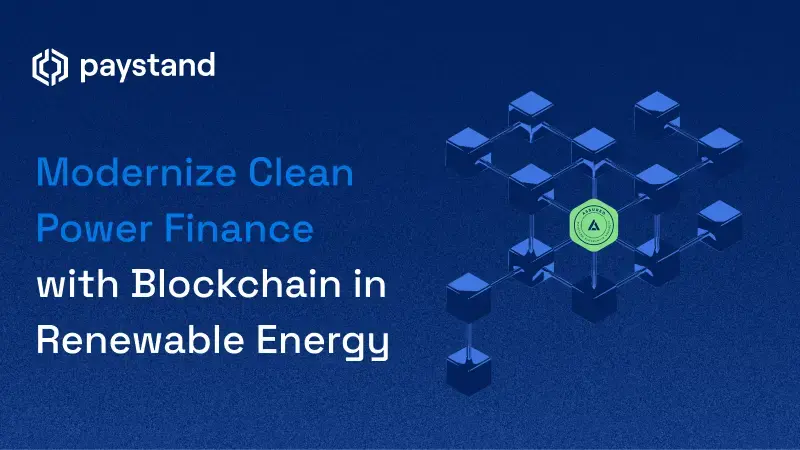Modernize Clean Power Finance with Blockchain in Renewable Energy

Table of Contents
- The rise of renewable energy around the world
- What is blockchain in renewable energy?
- Blockchain in renewable energy: transforming power trade and tracking
- Top blockchain platforms for renewable energy management
- Enhancing renewable energy security with blockchain tech
- Blockchain strategies for renewable energy development
- Paystand: driving the financial revolution in renewable energy
Key Takeaways
- Unpredictable cash flow threatens renewable energy companies, and outdated financial systems worsen this, especially in high-growth regions like Latin America.
- Blockchain transforms renewable energy with faster payments, peer-to-peer trading, and real-time tracking of power and carbon credits.
- Power Ledger, WePower, Energy Web Foundation, and Paystand are pioneering the digitization of energy distribution and financial operations.
- Blockchain boosts security, transparency, and cash flow in renewable energy projects, cutting administrative overhead and removing intermediaries.
- Paystand’s blockchain payment system enables renewable companies to automate AR, reduce costs, and scale sustainably, demonstrating that financial systems can match the renewability of the energy they support.
Cash flow is the lifeblood of every finance team, and when it’s unpredictable, everything from planning to operations suffers. For renewable energy companies operating in rapidly changing markets, optimizing cash flow isn’t just a metric; it’s a matter of survival. High upfront infrastructure costs, delayed subsidies, and the variability of power generation from sources like solar and wind often render liquidity management a significant challenge.
Here’s the tension: while renewable energy adoption accelerates, the financial systems supporting it are often outdated, siloed, and burdened with excessive paperwork. These inefficiencies slow down payments, limit visibility, and hinder the very agility that companies need to innovate. And yet, the solution is already here. Emerging technologies (especially blockchain) are transforming how renewable energy projects handle revenue, reporting, and reinvestment.
Before assuming your current setup is good enough, ask yourself: What if your entire energy payment infrastructure were as renewable as the energy you produce? Keep reading; we’re about to challenge everything you know about cash flow and show you what’s truly possible.
The Rise of Renewable Energy Around the World
Countries across continents are rapidly transitioning to wind, solar, hydro, and other clean energy sources, not only to lower carbon emissions but also to create more resilient and cost-effective energy systems.
The global momentum is undeniable. From offshore wind farms in the North Sea to solar megaprojects in India and battery-backed microgrids in sub-Saharan Africa, renewable energy is powering more of the planet every year. Government incentives, corporate ESG goals, and declining technology costs are accelerating adoption.
However, progress brings challenges. High capital expenditures, complex financing structures, and inconsistent regulatory frameworks often lead to bottlenecks, particularly in regions with developing infrastructure. This is where blockchain becomes a game-changer, offering a decentralized, transparent system to streamline payments, manage energy trading, and enhance financial oversight at scale.
What Is Blockchain in Renewable Energy?
At its core, blockchain is a decentralized digital ledger that securely, transparently, and immutably records transactions. When applied to the renewable energy sector, this technology enables everything from peer-to-peer energy trading to real-time verification of power plant output.
Imagine a future where each kilowatt-hour of surplus energy can be tokenized, verified, and sold instantly using smart contracts, without intermediaries or delays. This is already occurring in pilot programs throughout Latin America, where rural energy producers receive payments more quickly and fairly through blockchain-based platforms.
These systems not only enhance energy trading efficiency; they also establish the foundation for blockchain integration in renewable energy systems that emphasize trust, autonomy, and transparency.
Blockchain in Renewable Energy: Transforming Power Trade and Tracking
Is blockchain effective in renewable energy trading? Absolutely.
Traditional power grids rely on centralized control, where large utilities distribute energy and set prices. Blockchain disrupts this model. Through decentralized, peer-to-peer energy trading systems, homeowners and small producers can sell excess energy directly to their neighbors or back to the grid. Smart contracts automate these transactions, enforcing rules and processing payments without the need for third-party verification.
Case in point: Chile's SolarCoin initiative rewards solar panel owners with tokens for every megawatt-hour they generate. These tokens can be exchanged for services or reinvested into additional green infrastructure. This model doesn’t just reward sustainability; it monetizes it.
It’s not just limited to solar energy; wind-powered microgrids in Mexico and methane-to-energy projects in Guatemala are also utilizing blockchain technology. This innovation enhances cash flow and demonstrates the cost advantages of blockchain in renewable energy initiatives.
Top Blockchain Platforms for Renewable Energy Management
Several blockchain platforms are rising as leaders in the renewable energy sector worldwide:
- Power Ledger: Known worldwide for enabling peer-to-peer energy trading and smart grid management.
- WePower: Offers tokenized renewable energy contracts that streamline green energy transactions across Europe and beyond.
- Energy Web Foundation: Provides enterprise-grade blockchain infrastructure tailored for energy systems, with deployments in North America, Asia, and Europe.
These platforms help optimize energy usage, simplify global supply chain logistics, and increase revenue through real-time analytics and decentralized data.
On the financial side, platforms like Paystand are at the forefront of transforming how renewable energy companies handle payments. By utilizing blockchain in accounting and payments, Paystand facilitates real-time, automated, and feeless transactions that are fully auditable and tamper-proof. This enables energy companies to align their financial operations with environmental goals, ESG mandates, and the rapid pace of today’s global green energy markets.
Enhancing Renewable Energy Security with Blockchain Tech
A key advantage is blockchain's ability to enhance security in renewable energy systems. As power grids digitize, they become more vulnerable to cyberattacks. Blockchain’s decentralized architecture adds resilience, ensuring the system remains intact even if one node is compromised.
This enhanced security is crucial not only for energy generation but also for facilitating secure blockchain payments among producers, distributors, and consumers. It reduces fraud, lowers administrative costs, and speeds up settlement times, thus improving overall cash flow.
Blockchain Strategies for Renewable Energy Development
To stay ahead, companies must go beyond merely adopting blockchain; they need a comprehensive strategy. This involves integrating blockchain at every level of their energy company’s operations, from supply chain management to project financing.
Blockchain can be used to:
- Track carbon offset performance in real time
- Streamline the issuance of renewable energy certificates
- Enable dynamic pricing models based on demand and generation
These strategies drive cost reduction and revenue growth, showing that blockchain’s role in lowering renewable energy costs is real and measurable.
The Future of Green Energy Is Transparent, Trackable, and Tokenized
In short, blockchain is not merely a new tool. It represents a new foundation for how we understand value, trust, and efficiency in the energy sector.
By combining blockchain payments with transparent carbon markets and decentralized trading platforms, we’re seeing the rise of a fully circular energy economy. One that’s cleaner, faster, and more equitable.
And finance teams? They're reaping the benefits: better forecasting, lower operational costs, and a more efficient path to reinvestment.
Paystand: Driving the Financial Revolution in Renewable Energy
Where does Paystand fit into this picture? Right at the intersection of what blockchain technology is and what it can do for renewable energy.
Paystand uses enterprise blockchain to automate accounts receivable, reduce days sales outstanding, and eliminate transaction fees, all while offering the transparency, security, and efficiency today’s finance leaders need.
For renewable energy organizations, that means:
- Real-time, cashless settlements for energy sales
- Full payment traceability across the power plant-to-consumer lifecycle
- Smart contract functionality to enforce agreements and payments
- Blockchain-based carbon credit tracking and validation
Paystand’s platform aligns with the green energy mission by eliminating paper checks, reducing reliance on banks, and powering energy-efficient financial systems that scale.
Want to see how it's working in the real world? Allterra Solar, a leader in solar energy, cut its payment processing time by 60% after switching to Paystand. Their journey shows what happens when you challenge the status quo and adopt a finance system that moves as fast as your mission.
It’s time to stop retrofitting legacy systems to fit a future they weren’t built for. The financial revolution is happening now, powered by blockchain, automation, and clean energy.






